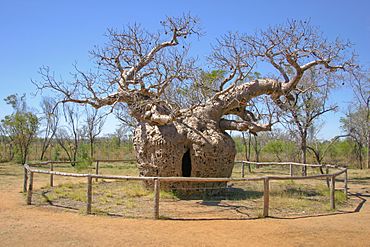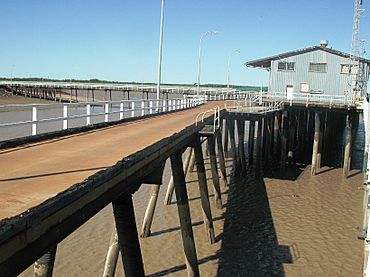Derby, Western Australia facts for kids
Quick facts for kids DerbyWestern Australia |
|||||||||
|---|---|---|---|---|---|---|---|---|---|

Local legend claims this boab tree near Derby was used as a prison, hence the name the "Boab Prison Tree"
|
|||||||||

Low tide at the Derby wharf on King Sound
|
|||||||||
| Lua error in Module:Location_map at line 416: Malformed coordinates value. | |||||||||
| Established | 1883 | ||||||||
| Postcode(s) | 6728 | ||||||||
| Elevation | 8 m (26 ft) | ||||||||
| Area | [convert: needs a number] | ||||||||
| Location | |||||||||
| LGA(s) | Shire of Derby-West Kimberley | ||||||||
| State electorate(s) | Kimberley | ||||||||
| Federal Division(s) | Durack | ||||||||
|
|||||||||
Derby (pronounced DUR-bee) is a town in the Kimberley region of Western Australia. In 2016, Derby had about 3,325 people living there. Nearly half of the residents (47.2%) were Aboriginal and Torres Strait Islander people. Derby is one of only three towns in the Kimberley region with more than 2,000 people. The other two are Broome and Kununurra.
Derby is located on King Sound. It is famous for having the highest tides in Australia. The water level can change by as much as 11.8 metres (39 ft) between low tide and high tide!
Contents
A Look at Derby's History
Derby is located on the traditional lands of the Nyiginka people. The town was officially started in 1883. It was named after Edward Stanley, who was the 15th Earl of Derby and a British government official.
Derby During World War II
During World War II, Derby was bombed by Japanese planes. This happened because the town had an air base and a jetty that Australian forces used.
Early Aviation in Australia
Derby played a big part in early Australian aviation. In the 1920s, it was the starting point for Australia's first regular airline service. This service was run by West Australian Airways Ltd. Their first flight was on December 5, 1921. At one point, the flight route from Perth to Derby was the longest passenger airline route in the world!
Medical Care and Community Growth
For many years, Derby Hospital helped many Aboriginal patients with Hansen's Disease, which was then called leprosy. The Derby Leprosarium (a special hospital for leprosy patients) operated from 1936 to 1986. Nuns, led by Sister Mary Gertrude, worked there.
In 1968, about 1,500 people lived in Derby. Many of them worked at the meatworks, which processed beef. A new road for transporting beef, costing A$900,000, was finished that same year. A large steel and concrete jetty, costing A$2 million, was also built in 1965. This helped to ship live cattle from the port.
Who Lives in Derby?
The 2016 census showed that 3,325 people lived in Derby.
- Almost half (47.2%) of the people were Aboriginal and Torres Strait Islander people.
- Most people (77.4%) were born in Australia. The next most common country of birth was New Zealand (3.4%).
- About 72.5% of people spoke only English at home. Other languages spoken included Kriol (6.2%).
- When asked about religion, the most common answers were No Religion (27.7%) and Catholic (26.8%).
Culture and Community Life
Derby has a rich and diverse culture, with Aboriginal Australian culture being a very important part of the community.
Festivals and Events
- The Mowanjum Festival is held every year at the Mowanjum Community, which is about 10 km (6.2 mi) south-east of Derby. This festival showcases amazing traditional art.
- The Boab Festival is named after the unique boab tree. This festival lasts for two weeks and includes fun events like mud football, watermelon seed spitting, and a Mardi Gras parade.
Important Services and Education
Derby has played a major role in the Royal Flying Doctor Service for the Kimberley region. This service provides medical care to people in remote areas.
The Kimberley School of the Air is also located in Derby. This school teaches primary-aged children who live in isolated places. These include cattle stations and remote Aboriginal communities across the huge 423,517 square kilometres (163,521 sq mi) Kimberley region.
Derby has two schools: Holy Rosary School Derby and Derby District High School. Derby District High School follows the "Stronger Smarter" vision. This idea, started by Chris Sarra, aims to raise expectations for the school and its community.
Local Museums and Galleries
- The Wharfinger's House Museum shares the story of the town's aviation history and its port.
- The Norval Gallery displays the artwork of Mark Norval. It also features a wide range of Indigenous artwork from all over the Kimberley.
Derby's Economy and Industries
Derby's economy relies on several industries. People find jobs in:
- Farming and Ranching: This includes the pastoral industry, which involves raising livestock.
- Mining: There are various mining activities nearby. Oil is found at Blina, and diamond mining happens at Ellendale. Granite is taken from the Wunaamin-Miliwundi Ranges, and lead and zinc are mined at Cadjebut. There is also an iron ore mine at Koolan Island. A big project to mine mineral sands is being developed at Thunderbird, about 100 kilometres (62 mi) west of Derby.
- Administration and Tourism: Many people also work in local government and in the tourism industry.
Tourism is especially important for Derby's economy between May and September. During these months, many visitors come to explore the region.
Derby's Climate
Derby has a hot semi-arid climate. This means it's generally hot and dry, but it does have a short, unpredictable wet season.
Wet and Dry Seasons
- The wet season usually lasts from late December to March. It brings hot, humid days and nights, with heavy but irregular rain showers. Some years might have very little rain, while others, like 1999–2000, might get more than a year's worth of rain in just one month! Derby can also be affected by strong tropical cyclones.
- The dry season runs from April to November. During this time, there is very little rain. Days are warm to hot, and nights are mild or cool.
Temperature Extremes
The highest temperature ever recorded in Derby was 47.8 °C (118.0 °F) on November 17, 1968. The lowest was 5.0 °C (41.0 °F) on July 21, 1965. The wettest month on record was January 1917, when 803.6 millimetres (31.64 in) of rain fell. On January 7, 1917, a huge 418.3 millimetres (16.47 in) of rain was recorded in just one day!
| Climate data for Derby Post Office (1883 to 1997) | |||||||||||||
|---|---|---|---|---|---|---|---|---|---|---|---|---|---|
| Month | Jan | Feb | Mar | Apr | May | Jun | Jul | Aug | Sep | Oct | Nov | Dec | Year |
| Record high °C (°F) | 45.2 (113.4) |
43.8 (110.8) |
42.8 (109.0) |
42.1 (107.8) |
39.4 (102.9) |
36.2 (97.2) |
36.7 (98.1) |
39.5 (103.1) |
42.8 (109.0) |
43.4 (110.1) |
47.8 (118.0) |
45.7 (114.3) |
47.8 (118.0) |
| Mean daily maximum °C (°F) | 35.0 (95.0) |
34.7 (94.5) |
35.3 (95.5) |
35.2 (95.4) |
32.4 (90.3) |
30.1 (86.2) |
29.6 (85.3) |
31.7 (89.1) |
34.2 (93.6) |
35.7 (96.3) |
36.5 (97.7) |
36.2 (97.2) |
33.9 (93.0) |
| Mean daily minimum °C (°F) | 25.9 (78.6) |
25.6 (78.1) |
25.2 (77.4) |
22.7 (72.9) |
19.2 (66.6) |
16.2 (61.2) |
14.7 (58.5) |
16.2 (61.2) |
19.4 (66.9) |
23.0 (73.4) |
25.5 (77.9) |
26.4 (79.5) |
21.7 (71.1) |
| Record low °C (°F) | 17.1 (62.8) |
19.4 (66.9) |
18.8 (65.8) |
13.9 (57.0) |
9.6 (49.3) |
5.8 (42.4) |
5.0 (41.0) |
8.0 (46.4) |
12.4 (54.3) |
14.0 (57.2) |
18.8 (65.8) |
20.3 (68.5) |
6.0 (42.8) |
| Average rainfall mm (inches) | 181.7 (7.15) |
157.3 (6.19) |
108.9 (4.29) |
31.0 (1.22) |
22.1 (0.87) |
10.4 (0.41) |
5.9 (0.23) |
1.3 (0.05) |
0.3 (0.01) |
2.5 (0.10) |
16.2 (0.64) |
83.1 (3.27) |
620.7 (24.43) |
| Average rainy days (≥ 0.2 mm) | 11.8 | 10.6 | 7.9 | 2.4 | 1.4 | 1.0 | 0.5 | 0.1 | 0.1 | 0.5 | 1.9 | 6.5 | 44.7 |
| Average relative humidity (%) | 67 | 69 | 63 | 52 | 45 | 44 | 40 | 39 | 43 | 51 | 55 | 61 | 52 |
| Source: Bureau of Meteorology | |||||||||||||
| Climate data for Derby Aero (1991 to 2020) | |||||||||||||
|---|---|---|---|---|---|---|---|---|---|---|---|---|---|
| Month | Jan | Feb | Mar | Apr | May | Jun | Jul | Aug | Sep | Oct | Nov | Dec | Year |
| Record high °C (°F) | 44.0 (111.2) |
43.8 (110.8) |
41.9 (107.4) |
41.5 (106.7) |
40.3 (104.5) |
36.6 (97.9) |
36.2 (97.2) |
39.3 (102.7) |
42.1 (107.8) |
44.8 (112.6) |
44.6 (112.3) |
45.6 (114.1) |
45.6 (114.1) |
| Mean daily maximum °C (°F) | 35.2 (95.4) |
34.6 (94.3) |
35.4 (95.7) |
35.8 (96.4) |
33.0 (91.4) |
30.7 (87.3) |
30.9 (87.6) |
32.7 (90.9) |
35.6 (96.1) |
37.3 (99.1) |
38.2 (100.8) |
37.2 (99.0) |
34.7 (94.5) |
| Mean daily minimum °C (°F) | 25.7 (78.3) |
25.5 (77.9) |
25.1 (77.2) |
22.8 (73.0) |
18.8 (65.8) |
15.8 (60.4) |
14.7 (58.5) |
15.8 (60.4) |
19.3 (66.7) |
23.2 (73.8) |
25.6 (78.1) |
26.3 (79.3) |
21.6 (70.9) |
| Record low °C (°F) | 19.2 (66.6) |
19.2 (66.6) |
19.3 (66.7) |
13.7 (56.7) |
9.1 (48.4) |
6.1 (43.0) |
6.0 (42.8) |
6.1 (43.0) |
9.1 (48.4) |
11.7 (53.1) |
19.0 (66.2) |
18.5 (65.3) |
6.0 (42.8) |
| Average rainfall mm (inches) | 224.9 (8.85) |
219.9 (8.66) |
149.8 (5.90) |
20.8 (0.82) |
22.7 (0.89) |
6.8 (0.27) |
9.6 (0.38) |
1.6 (0.06) |
0.7 (0.03) |
2.8 (0.11) |
15.2 (0.60) |
129.8 (5.11) |
804.6 (31.68) |
| Average rainy days | 14.8 | 13.2 | 11.1 | 3.3 | 1.9 | 1.0 | 0.8 | 0.2 | 0.2 | 1.3 | 2.3 | 10.0 | 60.1 |
| Average relative humidity (%) | 62 | 67 | 59 | 46 | 35 | 33 | 30 | 27 | 34 | 40 | 42 | 56 | 44 |
| Source: Bureau of Meteorology | |||||||||||||
Sports and Fun Activities
Derby offers a few options for sports and recreation. You can find a local lawn bowling club and the Derby Golf Club for those who enjoy a round of golf.
Notable People from Derby
- Keanu Pinder is a basketball player who was born and grew up in Derby.

